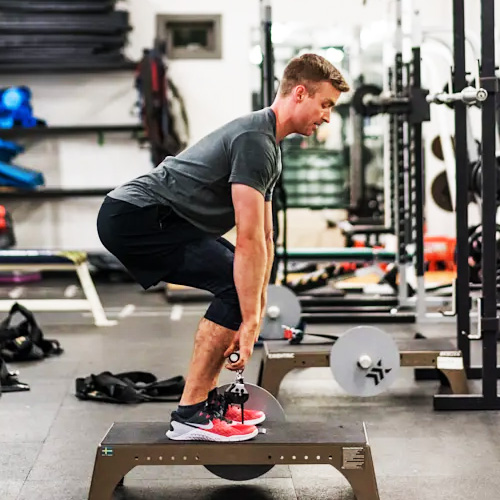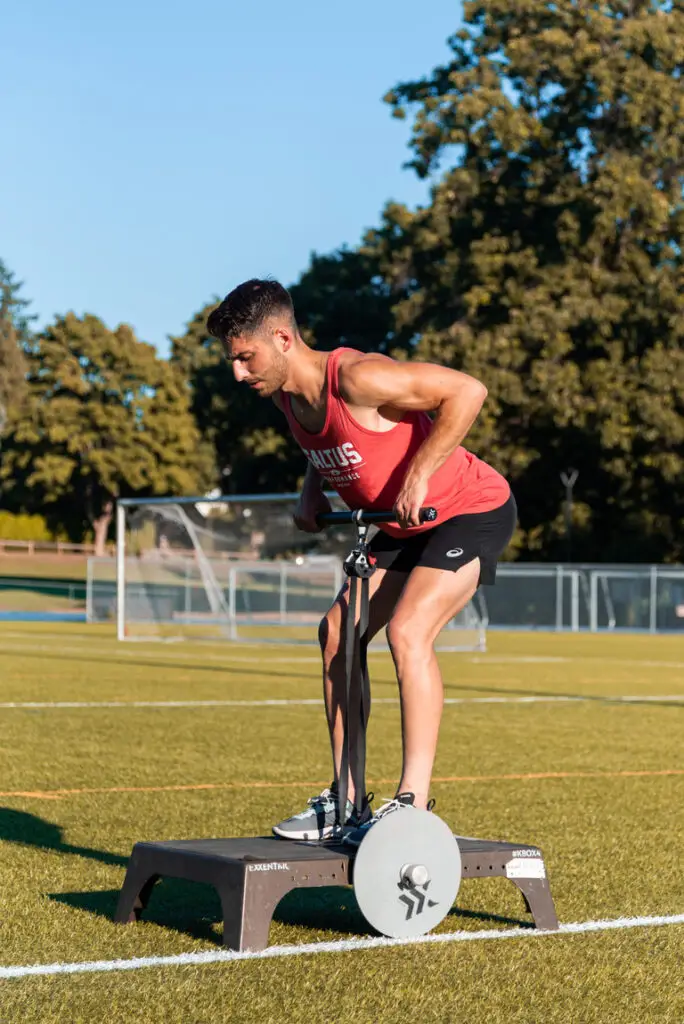For athletes, addressing long-term development while gaining success on the field, court or in their sporting arena is a constant pursuit. Training methods that enhance speed, strength, and power are invaluable resources, and flywheel training has emerged as a potent tool in this pursuit. In this blog, we’ll look into the physiological adaptations of utilizing the flywheel and why we incorporate the Exxentric Flywheel at Saltus Performance.

- Speed: Speed is often the differentiating factor in sports. Athletes who can move faster have a distinct advantage. Faster athletes can reach their goals more quickly and cover ground with greater efficiency.
- Strength: Strength refers to the ability to exert force against a resistance. For athletes, this translates to being able to overcome opposing forces, whether it’s lifting an opponent off the ground in wrestling, outmuscling a defender in basketball, or breaking through tackles in football.
- Power: Power combines both speed and strength. It’s the ability to generate force rapidly, allowing athletes to explode into action. Power is crucial for movements like jumping, throwing, and explosive bursts of speed.

Flywheel Training and Speed
Speed is often the differentiating factor in sports. Athletes who can move faster have a distinct advantage. Flywheel training can significantly impact speed through several physiological mechanisms:
- Improved Muscle Fiber Recruitment: Flywheel training demands rapid and forceful contractions of muscle fibres. Over time, this leads to enhanced motor unit recruitment—the body’s ability to activate more muscle fibres simultaneously. More muscle fibres in action mean more power and, subsequently, greater speed.
- Enhanced Neuromuscular Coordination: Flywheel training requires precise coordination between muscles and nerves. Athletes who engage in this training develop better neuromuscular coordination, resulting in smoother, more efficient movements and, ultimately, greater speed.
- Increased Rate of Force Development (RFD): Speed relies on the ability to generate force rapidly. Flywheel training, with its variable resistance, is excellent for developing RFD. The resistance increases as you accelerate the flywheel, mirroring the demands of explosive movements in sports.
- Improved Sprint Mechanics: Flywheel training can target specific muscle groups involved in sprinting, such as the hip flexors and quadriceps. Athletes can improve their sprint mechanics by strengthening these muscles, driving their top-end speed.
- Eccentric Loading: Eccentric muscle contractions, where muscles lengthen under tension, are crucial for deceleration in sports. Flywheel training’s eccentric loading can enhance an athlete’s ability to control deceleration, making them more agile and capable of rapid changes in direction.
Flywheel Training and Strength
- Muscle Hypertrophy: Flywheel training’s eccentric focus promotes muscle hypertrophy—the enlargement of muscle fibers. Larger muscles can generate more force, giving athletes an advantage in strength-dependent sports.
- Eccentric Overload: The kBox and similar flywheel devices excel at eccentric loading. Eccentric training, where muscles contract while lengthening, is particularly effective in building strength. It challenges muscles in ways that traditional weightlifting cannot.
- Greater Resistance Variability: Flywheel training provides variable resistance throughout the range of motion. This means that the resistance increases as an athlete becomes stronger and applies more force. Traditional weights, in contrast, offer static resistance.
- Improved Muscle Recruitment: Flywheel training recruits a wide spectrum of muscle fibers, including fast-twitch fibers responsible for explosive strength. Over time, this results in greater force production.
- Reduced Risk of Plateaus: The dynamic nature of flywheel training means that athletes are less likely to hit strength plateaus. Traditional weightlifting can become less effective as an athlete adapts to a fixed resistance level.
Flywheel Training and Power
- Explosive Contractions: Flywheel training demands rapid, explosive contractions. This mirrors the demands of sports where power is crucial, such as jumping, throwing, or starting a sprint.
- Rate of Force Development (RFD): As mentioned earlier, flywheel training enhances RFD. This ability to generate force quickly is a hallmark of power. Athletes who can produce high forces in short time intervals can execute explosive movements with precision.
- Full-Body Engagement: Many flywheel training exercises engage multiple muscle groups simultaneously. This full-body engagement promotes power development by harnessing the strength of multiple muscle chains.
- Sport-Specific Power: Flywheel training allows athletes to mimic sport-specific movements, such as a golf swing or a tennis serve, with resistance. This sport-specific power development translates directly into improved on-field or on-court performance.

- “Iso” denotes “equal” or “constant.” In the context of isoinertial resistance, the resistance should remain relatively constant or align with the user’s effort throughout the entire range of motion.
- “Inertial” pertains to inertia, which is the property of an object to resist changes in its state of motion. Concerning resistance training it refers to the resistance provided by the equipment or device used, which should be responsive to the user’s movements and force application.

In conclusion, flywheel training is a versatile and effective method for athletes seeking to elevate their speed, strength, and power. By targeting specific physiological adaptations, this training approach provides the tools athletes need to excel in their respective sports. Whether you’re a sprinter aiming for a faster finish, a football player looking to dominate the field, or an athlete in any other discipline, flywheel training may hold the key to unlocking your full potential and gaining the competitive advantage you desire.
If you have any questions or need assistance with your training preparations, do not hesitate to contact us at [email protected] or call us at 778-788-5438.
